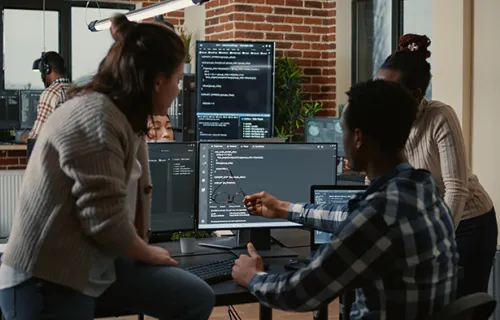The President’s Management Agenda (PMA) places people at the forefront, including constituents to government services and the federal workforce itself. The administration further emphasized the importance of meeting citizen and end user needs through Office of Management and Budget Circular A-11, Section 280 (Managing Customer Experience and Improving Service Delivery), and Executive Order 14058 (Transforming Federal Customer Experience and Service Delivery to Rebuild Trust in Government). These orders drive new attention to federal employees’ experience using government systems, especially as the government makes significant investments to modernize their systems.
But how do agencies ensure that their modernization investments truly meet users’ needs? The government’s adoption of agile methodologies has made CIO IT shops more responsive to customer needs, emphasizing the importance of user experience. However, to truly improve experience, government employees must take ownership and act as champions of new systems and agency modernization initiatives.
Prioritizing people in digital transformation
“Think of digital transformation less as a technology project to be finished than as a state of perpetual agility, always ready to evolve for whatever customers want next, and you’ll be pointed down the right path.” Amit Zavery, VP and Head of Platform, Google Cloud
“Digital transformation” is a common term, widely understood at a high level but often ill-defined. The above quote sheds light on this process, including the concept of “a state of perpetual agility.” But the most important element of the statement is this: “always ready to evolve for whatever customers want next.”
Federal leaders are facing “need now,” not “want next.” Unfortunately, the needs of end users are often relegated to limited aspects of the systems development lifecycle—a focus group or usability testing during design, a limited number of “super users” during user acceptance testing, or a user training program after the system is developed.
Increasingly, our federal clients recognize that true digital transformation requires targeted focus on system users—and not only during design or training, but at all phases of the lifecycle. Disciplines such as human-centered design (HCD) and organizational change management (OCM) have been introduced to federal modernization efforts. Often, however, these two disciplines work separately, with HCD personnel focused primarily on the design of business flows and web pages, while OCM experts focus on communication about the change and training. This disjointed approach limits the value of both disciplines, individually and collectively.
HCD and OCM: Two keys to digital transformation success
Successful digital transformation projects require a close alignment between HCD and OCM at all phases of the lifecycle, including post go-live. Increased alignment of the two disciplines helps drive key measures of transformation success such as increased usability, alignment of processes to business needs and high levels of end user adoption. An adopted system—one that end users want to use because it improves their efficiency, eases interactions with the government or enhances the way in which they deliver on the mission—should be paramount in measuring success.
As an OCM practitioner, I collaborate with HCD experts on federal modernization efforts. Here are some best practices to align HCD and OCM disciplines throughout the lifecycle:
- Adopt iterative processes. While HCD experts are familiar with working within agile teams, OCM models, such as the ProSci ADKAR model, are typically more linear approaches, aligned to waterfall development. At CGI, we’ve tailored the ADKAR model to better align with agile ways of working. Making both HCD and OCM processes iterative has introduced opportunities for closer collaboration during each sprint. By working together to align human elements of design and change management concurrently, we ensure a more cohesive and complementary approach to both disciplines.
- Employ a multidisciplinary model. HCD and OCM are by nature multidisciplinary. Within CGI Federal, we apply a matrixed approach wherein our HCD and OCM experts, while sitting within their respective practices, are deployed into cross-functional teams. Our HCD and OCM experts are adept at working within and across agile teams, and can quickly ascertain their project-specific goals. HCD and OCM often become the connective tissue between agile release trains and together keep end user needs at the forefront at all phases of the project.
- Integrate HCD and OCM strategies. When approaching a modernization effort, OCM takes a top-down view, ensuring the modernization meets the strategic objectives of the organization. At the same time, OCM recognizes that the key to making changes to any system are the people operating within it. HCD takes a more bottom-up approach, starting with end user needs and the stakeholder business goals to create a unified product vision. Working together at all phases of the modernization, OCM and HCD experts can effectively align changes in systems and business processes, and ensure that training and communication strategies reflect user sentiments uncovered during design. At the tactical level, HCD and OCM experts can collaborate on writing on-screen instructions and training documentation to ensure that end users understand the new ways of working and want to adopt them.
- Focus on knowledge sharing. For any development team, it’s important to keep documentation in a centralized repository so that all team members have access to others’ work. Sharing allows for creation of reusable assets and templates, and enables multiple agile release trains to better align with shared standards and best practices. But there is more to knowledge sharing than simply shared repositories. Knowledge management and, specifically, knowledge sharing, supports value creation across the full lifecycle of the digital transformation project. By capturing information, categorizing and analyzing it, HCD and OCM experts can provide strategic recommendations to reduce risk—risks such as failure of adoption. Teams can identify trends over time—for example, decreased user satisfaction with online help functionality as the system is iteratively developed—to inform human-centered design decisions.
- Take action based on performance metrics. Performance metrics are most actionable when they are SMART (Specific, Measurable, Attainable, Realistic, and Time-bound) and directly reflect the project’s desired attitudes, behaviors and results. Teams should measure qualitative and quantitative results over time to assess changes in end user sentiment—changes that could impact adoption failure or success. HCD and OCM disciplines advocate using a variety of methods for collecting data from end users, including surveys, polls, focus group discussions and usability testing. Teams must watch for changes in answers received through different methods. Someone may answer a question one way during a one-on-one discussion and differently when responding to an online survey. Simple changes in the wording of questions can change the way users perceive your intent, and therefore, their answers. When OCM and HCD teams work together to collect and analyze data, they are able to make better informed assessments with concrete, evidence-based recommendations for client and agile team action.
Delivering results through alignment of HCD and OCM
How is your organization approaching user experience and the promise of adoption throughout the lifecycle of your digital transformation projects? To what extent are your teams employing HCD and OCM, and how are they working together to deliver value?






